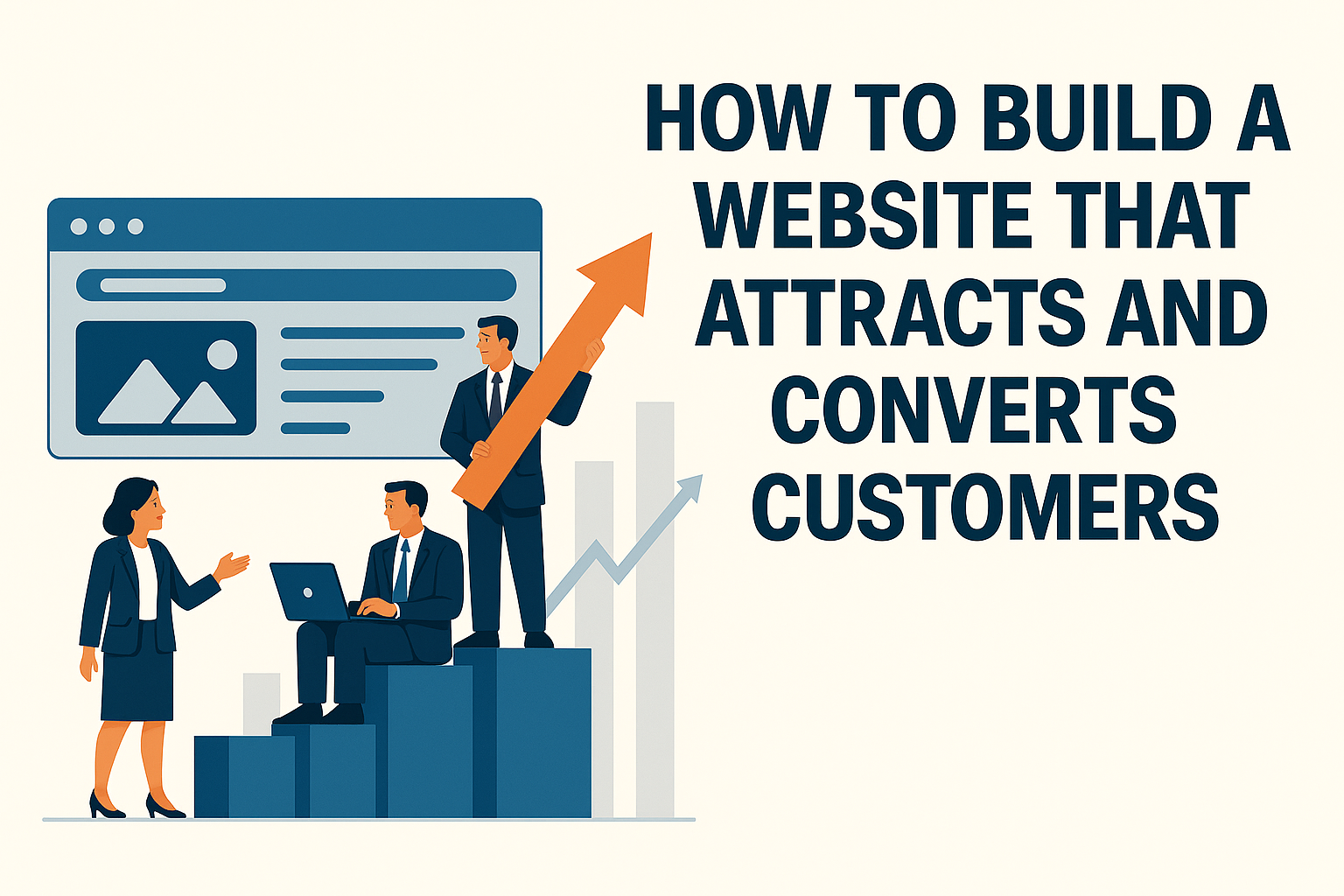In today’s digital landscape, your website acts as your brand’s most powerful marketing asset—serving as your online storefront, sales engine, and customer service platform. Yet, many small businesses face challenges in Building a websites that not only draw traffic but also convert visitors into loyal customers

In this comprehensive guide, we’ll walk you through the key strategies to build a website that grabs attention, builds trust, and drives conversions.
- 1. Start With Strategy to build a website, Not Just Style
- 2. Clear and Compelling Messaging in your website
- 3. Design for Trust and Simplicity
- 4. Mobile-First, Always
- 5. Speed and Performance Optimization
- 6. Guide Visitors With Clear CTAs
- 7. SEO Basics: Get Found Organically
- 8. Build Trust With Content That Educates
- 9. Use Analytics to Continuously Improve
- 10. Don’t Forget the Human Touch
- Final Thoughts: Build to Convert, Not Just Impress
- Ready to turn your website into a growth machine? Let's build it together.
- What makes a website “high-converting”?
- How long does it take to build a conversion-focused website?
- Do I need a professional designer, or can I use a website builder?
- How often should I update my website for better results?
- What are the must-have features for small business websites?
- Can a good website design really increase my sales?
1. Start With Strategy to build a website, Not Just Style
Before you dive into picking fonts, colors, or layouts, you need to lay a solid foundation based on your business goals and customer needs. Too many business owners jump straight into aesthetics, missing the most critical part of web design: strategy.
Ask yourself:
- Who exactly is your target audience?
- What key problems do they face, and how do you solve them?
- What action do you want users to take on each page?
By answering these questions, you begin crafting a user experience that is intentional, purposeful, and optimized for results. Google algorithms
Pro tip: Avoid the common trap of trying to appeal to everyone. The more specific and focused your website messaging is, the more it will resonate with the right people—those who are most likely to convert.
2. Clear and Compelling Messaging in your website
The average website visitor makes a judgment about your brand in just a few seconds. That’s why it’s absolutely essential to make your value proposition clear the moment someone lands on your homepage.
Great messaging checklist:
- Your headline communicates a clear benefit (not just what you do, but why it matters)
- Your subheadline expands on your offer and how it solves a problem
- Your call to action (CTA) is simple, specific, and inviting
Clarity beats cleverness. Avoid overused buzzwords and industry jargon. Instead, use plain language that emphasizes the transformation your service or product provides.
3. Design for Trust and Simplicity
A beautiful website can grab attention—but a clean, trustworthy design will keep it. Your layout, typography, and imagery should all be geared toward creating a seamless experience that builds credibility and reinforces your brand.
Key trust-building elements to include:
- Client testimonials that speak to results
- Logos of companies you’ve worked with
- Industry awards or certifications
- Case studies or success stories
- Transparent contact information and easy navigation
Visual clutter can distract from your message. Embrace white space and focus on a clear visual hierarchy that naturally guides the visitor’s eye.
4. Mobile-First, Always
Did you know that over 60% of all web traffic now comes from mobile devices? If your website isn’t optimized for mobile users, you could be turning away more than half of your potential customers.
Mobile-first web design ensures:
- Lightning-fast load times on phones and tablets
- Clear, tappable call-to-action buttons
- Content that adapts gracefully to small screens
In addition, Google prioritizes mobile-friendly websites in search rankings. So designing for mobile isn’t just good for user experience—it’s essential for visibility too.
5. Speed and Performance Optimization
No one likes a slow website. In fact, studies show that if your page takes longer than 3 seconds to load, over 50% of visitors will leave. Site speed is one of the most underrated conversion killers out there.
Tips to turbocharge your website performance:
- Compress large images without losing quality
- Use lazy loading to delay loading off-screen images
- Minimize or eliminate unnecessary plugins and scripts
- Use a content delivery network (CDN) to serve content faster
Regularly test your website speed using tools like Google PageSpeed Insights, GTmetrix, or Pingdom. Make performance optimization a continuous priority.
6. Guide Visitors With Clear CTAs
Don’t leave your visitors wondering what to do next. Each page should have one main objective and a clear call to action (CTA) that nudges the visitor in the right direction.
Best practices for effective CTAs:
- Use action-oriented language (e.g., “Schedule Your Free Demo,” “Get Instant Access,” “Claim Your Offer”)
- Make CTA buttons large, bold, and easy to find
- Place CTAs in high-visibility areas: top, middle, and bottom of your pages
Great websites guide users like a GPS—there’s always a next step, clearly marked and easy to follow.
7. SEO Basics: Get Found Organically
You can’t convert customers if they can’t find you. That’s where search engine optimization (SEO) comes into play. SEO helps your website appear in search results when potential customers are actively looking for what you offer.
Essential SEO practices to follow:
- Include targeted keywords in your page titles, URLs, and headers
- Write high-quality, useful content that answers search queries
- Add alt tags to all images for accessibility and ranking
- Create internal links to guide users and search engines across your site
Blogging regularly on topics your audience cares about is another great way to boost visibility and build authority in your niche.
8. Build Trust With Content That Educates
One of the most powerful ways to convert website visitors into customers is by educating them first. When you provide valuable, informative content, you position yourself as a trusted expert—not just another vendor.
High-converting content ideas:
- How-to blog posts and educational guides
- Frequently Asked Questions (FAQs)
- Detailed case studies showcasing client results
- Free resources like checklists, templates, or eBooks
The more questions your content answers, the more confidence you build with potential buyers. Great content shortens the sales cycle by making visitors feel informed and empowered.
9. Use Analytics to Continuously Improve
The first version of your website won’t be perfect—and that’s okay. What matters is using data to iterate and improve.
Track key metrics like:
- Bounce rate (Are visitors leaving quickly?)
- Time on page (Are they reading your content?)
- Conversion rate (Are they taking desired actions?)
- Scroll depth (Are they engaging with long pages?)
Tools like Google Analytics, Hotjar, and Microsoft Clarity offer powerful insights into user behavior. Use heatmaps, click tracking, and user recordings to see what’s working and what’s not.
10. Don’t Forget the Human Touch
In a world dominated by automation and AI, the human element of your website can be a major differentiator. People want to do business with people—not faceless brands.
Humanize your brand by including:
- Authentic photos of your team, not stock images
- An About page that shares your story and mission
- A friendly, conversational tone of voice
- Personalized confirmation messages or thank-you emails
Even in a digital environment, relationships still matter. Make your website feel warm, relatable, and genuinely helpful.
Final Thoughts: Build to Convert, Not Just Impress
Creating a website that converts is about more than pretty pixels. It’s about combining smart strategy, persuasive messaging, intuitive design, and ongoing refinement. Your website should be a living, evolving asset that helps grow your business day and night.
Whether you’re a solo entrepreneur, a small team, or a high-potential startup—your website should work as hard as you do.
What makes a website “high-converting”?
A high-converting website is one that guides visitors toward a clear goal—like making a purchase or booking a call—through strategic design, compelling content, and intuitive user experience.
How long does it take to build a conversion-focused website?
Typically, 3 to 6 weeks, depending on the complexity of the site and the readiness of content. Faster turnarounds are possible with clear goals and streamlined collaboration.
Do I need a professional designer, or can I use a website builder?
DIY builders like Wix or Squarespace are good for basic needs, but for growth-oriented businesses aiming to scale, a professionally designed website provides better performance, customization, and ROI.
How often should I update my website for better results?
Review performance monthly and make design/content updates quarterly. Regular optimization helps maintain speed, SEO rankings, and engagement.
What are the must-have features for small business websites?
Clear CTAs, mobile responsiveness, fast load times, SEO optimization, and trust-building elements like testimonials and contact info are essential.
Can a good website design really increase my sales?
Yes. Strategic web design builds trust, reduces friction, and guides visitors toward conversion actions—directly impacting your revenue.

